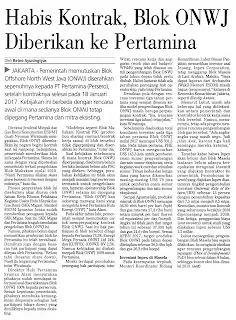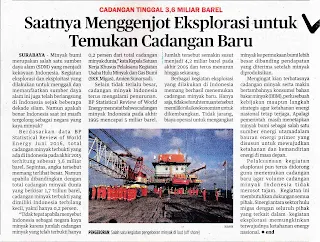Pemerintah memutuskan Blok Offshore North West Java (ONWJ) diserahkan sepenuhnya kepada PT Pertamina setelah kontraknya selesai pada 18 Januari 2017. Kebijakan ini berbeda dengan rencana awal di mana sedianya Blok ONWJ tetap dipegang Pertamina dan mitra eksisting. Direktur jenderal Minyak dan Gas Bumi Kementerian ESDM I Gusti Nyoman Wiratmaja mengatakan, Blok ONWJ dikembalikan ke negara begitu kontrak saat ini rampung. Selanjutnya, pemerintah memberikan blok ini kepada Pertamina.
Skema ini sama dengan yang diputuskan pemerintah terkait pengelolaan Blok Mahakam mulai 2018. Proses penyerahan blok ini disebutnya akan diurus oleh Satuan Kerja Khusus Pelaksana Kegiatan Usaha Hulu Minyak dan Gas Bumi (SKK Migas). Menteri ESDM Ignasius Jonan sudah memberikan penugasan kepada SKK Migas. Saat ini, SKK Migas dan Pertamina sedang membahas pengelolaan Blok ONWJ. Pihaknya belum dapat memastikan pemberian blok ke Pertamina itu telah terealisasi. Demikian juga dengan besaran hak partisipasi yang dapat dilepas oleh Pertamina.
Direktur Hulu Pertamina Syamsu Alam menyatakan pihaknya sudah mendapat informasi soal diserahkannya Blok ONWJ 100% kepada perseroan. Sesuai keputusan pemerintah, pihaknya membuka kemungkinan dilepasnya sebagian hak partisipasi (share down) yang dimilikinya kepada mitra eksisting. Modelnya seperti Blok Mahakam. Kontrak PSC (production sharing contract/ kontrak kerja sama) di blok tersebut tidak diperpanjang dan diserahkan ke Pertamina.
Soal kebijakan sebelumnya di mana kontrak Blok ONWJ diperpanjang, disebutnya belum berlaku lantaran belum ada PSC yang ditanda tangani. Sehingga, perubahan kebijakan ini tidak akan menjadi masalah bagi perseroan termasuk untuk pengelolaannya, karena operatorship Blok ONWJ selama ini dipegang Pertamina. Pada akhir tahun lalu, pemerintah sempat memutuskan untuk memperpanjang kontrak Blok ONWJ. Saat itu hak partisipasi di blok tersebut dibagi kepada Pertamina 73,5%, Energi Mega Persada ONWJ Ltd 24%, dan KUFPEC (ONWJ) BV 2,5%. Namun kebijakan ini diubah menjadi Blok ONWJ 100% untuk Pertamina.
Meski terdapat perubahan pemegang hak partisipasi, rencana kerja dan anggaran (work plan and budget/ WP&B) yang telah disusun untuk pengembangan Blok ONWJ pada tahun depan tidak perlu diubah. Hal ini lantaran tidak ada perubahan pemegang hak operatorship, yaitu tetap Pertamina. Demikian pula dengan rencana investasi tiga tahun pertama yang sempat disusun ketika model pengembangan Blok ONWJ masih berupa perpanjangan kontrak.
Sebelumnya disebutkan total komitmen investasi pada tiga tahun pertama Blok ONWJ mulai 2017 mencapai US$ 301,3 juta. Pada tahun pertama, PHE ONWJ harus mengucurkan US$ 143,3 juta untuk pemboran enam sumur pengembangan dan satu sumur eksplorasi, serta kegiatan work over dan stimulasi sumur. Tahun kedua dan ketiga dana yang harus dikucurkan masing-masing US$ 79 juta untuk pemboran enam sumur pengembangan dan satu sumur eksplorasi. Sampai Agustus lalu, produksi minyak di Blok ONWJ mencapai 36,39 ribu barel per hari (bph) dan gas rata-rata 27,8 ribu boepd. Angka ini tidak jauh dari target tahun ini sebesar 37.300 bph dan gas 24,6 ribu boepd.
Sesuai APBN 2017, target produksi Blok ONWJ pada tahun depan ditetapkan sebesar 36,5 ribu bph dan gas 26,3 ribu boepd. Investasi Inpex di Masela Menteri Koordinator Bidang Kemaritiman Luhut Binsar Panjaitan memastikan investor asal Jepang, Inpex Corporation, tetap menggarap Blok Masela di Laut Arafura, Maluku. Menurut Luhut, masih ada beberapa hal yang didiskusikan antara pemerintah dan kontraktor kontrak kerja sama blok tersebut. Menurutnya, tetap ada progres mengenai rencana pengembangan blok gas tersebut.
Inpex akan keluar dari Blok Masela Karena belum adanya kesepakatan mengenai insentif yang diajukan kontraktor ke pemerintah. Permohonan insentif yang diajukan Inpex diantaranya tingkat pengembalian investasi (Internal Rate of Return/IRR) sebesar 15 persen dengan penambahan kapasitas dari 7,5 mtpa menjadi 9,5 mtpa. Kemudian, moratorium kontrak yang seharusnya berakhir 2028 diperpanjang menjadi 2038. Dan ketiga, penggantian biaya (cost recovery) untuk studi yang dilakukan Inpex sebesar US$ 1,2 miliar.
Luhut menargetkan pengembangan Blok Masela bisa segera dilakukan. Ia menginstruksikan agar rencana pengembangan lapangan (Plan of Development/PoD) bisa selesai dalam 8 bulan, sehingga konstruksi bisa dimulai 2019.
IN ENGLISH
The contract runs out, ONWJ Awarded to Pertamina
The government decided the Offshore North West Java (ONWJ) left entirely to PT Pertamina after his contract was completed on January 18, 2017. This policy is different from the original plan which was originally ONWJ still held by Pertamina and existing partners. Director General of Oil and Gas Ministry of Energy and Mineral Resources said I Gusti Nyoman Wiratmaja, ONWJ returned to the state once the contract is now completed. Furthermore, the government give this block to Pertamina.
This scheme is similar to that related government decided Mahakam block management began in 2018. The process of handing this block calls will be managed by the Special Unit of Upstream Oil and Gas (SKK Migas). ESDM Minister Ignatius Jonan has given the assignment to SKK Migas. Currently, SKK Migas and Pertamina are discussing ONWJ management. It has not been able to ensure the provision of blocks to Pertamina had been realized. Likewise, the amount of participation rights that can be removed by Pertamina.
Pertamina Upstream Director Syamsu Alam said it had received information about the deposit of ONWJ 100% to the company. Following the decision of the government, it opens the possibility of the release of some of the rights of participation (share down) owned to existing partners. Models such as the Mahakam block. Contracts PSC (production sharing contract / contract of cooperation) in the block are not renewed and submitted to Pertamina.
About the previous policy where ONWJ extended contract, he called not apply because there is no PSC signed. Thus, this policy change will not be a problem for the company including its management, as operatorship of the ONWJ had been held by Pertamina. At the end of last year, the government had decided to extend the contract ONWJ. When the rights of participation in the block is divided to Pertamina 73.5%, Energi Mega Persada ONWJ Ltd. 24%, and KUFPEC (ONWJ) BV 2.5%. However, this policy was changed to ONWJ 100% for Pertamina.
Although there is a change in the holder of the rights of participation, work plan and budget (work plan and budget / WP & B) has been prepared for the development ONWJ next year do not need to be changed. This is because there is no change in operatorship rights holders, namely fixed Pertamina. Similarly, the first three-year investment plan which was drawn up when the development model ONWJ still a contract extension.
Previously mentioned total investment commitments in the first three years ONWJ began in 2017 reached US $ 301.3 million. In the first year, PHE ONWJ must disburse US $ 143.3 million to drill six development wells and one exploration well, as well as the activities of work over and stimulation of wells. Second and third year funds to be disbursed each costing US $ 79 million to drill six development wells and one exploration well. Until last August, oil production in ONWJ reached 36.39 thousand barrels per day (bpd) and gas average 27.8 thousand boepd. This figure is not far from this year's target of 37,300 bpd and gas 24.6 thousand boepd.
In accordance APBN 2017 ONWJ production target for next year is set at 36.5 thousand barrels per day and gas 26.3 thousand boepd. Inpex Masela investment in maritime Coordinating Minister Luhut Binsar Panjaitan ensure investors from Japan, Inpex Corporation, continue to cultivate the Masela block in the Arafura Sea, Maluku. According Luhut, there are still some things to be discussed between the government and the cooperation contract of the block. According to him, there remains a progress regarding the development plans of the gas block.
Inpex Masela will exit Due to lack of agreement regarding the proposed incentives to government contractors. Inpex petition filed incentives including investment rate of return (Internal Rate of Return / IRR) of 15 percent with the addition of capacity from 7.5 mtpa to 9.5 mtpa. Then, a moratorium on contracts that should have ended in 2028 was extended to 2038. And third, the replacement cost (cost recovery) to study Inpex of US $ 1.2 billion. Luhut targeting the development of the Masela Block can be done immediately. He instructed that the field development plan (Plan of Development / PoD) can be completed in eight months, so that construction can begin in 2019.
Investor Daily, Page- 9, Wednesday, Nov,23,2016

















